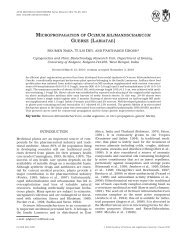ACTA BIOLOGICA CRACOVIENSIA
ACTA BIOLOGICA CRACOVIENSIA
ACTA BIOLOGICA CRACOVIENSIA
You also want an ePaper? Increase the reach of your titles
YUMPU automatically turns print PDFs into web optimized ePapers that Google loves.
16 TH INTERNATIONAL SYMPOSIUM ON CAROTENOIDS<br />
of its own thermal degradation. At 140 and 220°C, the reduction<br />
of 7-OOH formation was 26 and 56%, respectively. However, at<br />
180°C, 7-OOH content doubled in comparison to pure cholesterol<br />
model system. Moreover, systems containing β-carotene also<br />
delayed the time to achieve the maximum COP formation.<br />
A decrease in 7k amounts occurred at all temperatures; however,<br />
the reduction of the other COP was only noticed at 220°C. At<br />
180°C only the levels of β-EP and 7β-OH reduced, while at 140°C,<br />
only the contents of α-and β-EP decreased. Those differences<br />
could be explained by the action of β-carotene at the distinct pathways<br />
of cholesterol oxidation mechanisms as well as cholesterol<br />
conformation during heating.<br />
Acknowledgements: CNPq and FAPESP.<br />
3.3.<br />
Effect of annatto powder on lipid oxidation in<br />
pork patties during frozen storage<br />
Isabela Jorge Trad, Bruno Chacon, Neura Bragagnolo<br />
Department of Food Science, University of Campinas, Postal Code<br />
13083-862, Campinas, SP, Brazil, neura@fea.unicamp.br<br />
The antioxidant activity of annatto seeds is mainly attributed to<br />
its major carotenoid bixin. The effects of annatto powder on lipid<br />
oxidation in pork meat were evaluated and compared to sodium<br />
erythorbate, a synthetic antioxidant, usually added to meat products.<br />
Annatto powder alone or combined with sodium erythorbate<br />
was added to minced pork loin. Four types of patties were<br />
formulated, (1) the control without addition of annatto or sodium<br />
erythorbate, (2) addition of 0.05% annatto, (3) 0.1% sodium erythorbate<br />
and (4) 0.05% annatto plus 0.1% sodium erythorbate.<br />
The patties were packed in polyvinyl chloride film, stored at -18°C<br />
for 120 days and grilled at 165°C, for approximately 4 minutes<br />
per side, before analysis. Measurements of thiobarbituric acid<br />
reactive substances (TBARS), levels of conjugated dienes, cholesterol<br />
oxides contents and fatty acids composition were carried out<br />
in order to follow the lipid oxidation. Simultaneously, the stability<br />
of bixin in the pork patties during storage time was evaluated.<br />
In general, the levels of conjugated dienes showed no significant<br />
differences during 120 days. Patties containing annatto, sodium<br />
erythorbate and annatto plus sodium erythorbate showed significantly<br />
lower TBARS levels than the control patties during storage.<br />
Annatto showed the same protection levels as sodium erythorbate<br />
on cholesterol oxidation. Bixin contents in pork patties with<br />
annatto were always higher than those in the patties with annatto<br />
plus sodium erythorbate. These values decreased until day 75,<br />
remaining constant until the end of storage. The pork patties with<br />
sodium erythorbate and sodium erythorbate plus annatto showed<br />
low losses of polyunsaturated and monounsaturated fatty acids<br />
contents during storage. The overall results showed that annatto<br />
is an efficient antioxidant and can be used as an alternative for<br />
food industry to protect the lipids and cholesterol from oxidation<br />
in pork meat.<br />
Acknowledgements: CNPq and FAPESP.<br />
3.4.<br />
Screening of antioxidant activity of extracts<br />
from husks of Chinese lantern (Physalis<br />
alkekengi L.)<br />
Luèka Brulc 1 , Breda Simonovska 1 , Irena Vovk 1,2 ,<br />
Helena Abramoviè 3<br />
1 National Institute of Chemistry, Laboratory for Food Chemistry,<br />
Hajdrihova 19, SI-1000 Ljubljana, Slovenia, lucka.brulc@ki.si,<br />
breda.simonovska@ki.si, irena.vovk@ki.si<br />
2 EN-FIST Centre of Excellence, Dunajska 156, SI-1000 Ljubljana,<br />
Slovenia, irena.vovk@enfist.si<br />
3 University of Ljubljana, Biotechnical Faculty, Department of Food<br />
Chemistry and Biochemistry, Jamnikarjeva 101, SI-1000<br />
Ljubljana, Slovenia, helena.abramovic@bf.uni-lj.si<br />
Compounds as carotenoids, flavonoids and triterpenoids belong<br />
to plant secondary metabolites. Some of the secondary metabolites<br />
have beneficial role in healthy functioning of animal and<br />
human organisms. For example among carotenoids, zeaxanthin<br />
and lutein are reported (Ma and Lin, 2009) to have important role<br />
in eye health.<br />
Chinese lanterns (Physalis alkekengi L.) is a well-known<br />
ornamental plant. It was found to be a good source of carotenoids<br />
zeaxanthin and β-cryptoxanthin (Weller and Breithaupt, 2003;<br />
Pintea et al., 2005). Other components of different parts of the<br />
plant are less known and no in vitro antioxidant activity profile<br />
has been published yet.<br />
The aim of this study was to find the optimal extraction conditions<br />
for acquiring different groups of compounds present in<br />
the dried orange husks of Physalis alkekengi and measuring<br />
antioxidant activity of the extracts in vitro by different published<br />
tests. Consecutive extraction was made with n-hexane, ethyl<br />
acetate, methanol and 70% methanol (aq) in this order. Screening<br />
of different groups of compounds in the extracts was done by<br />
thin-layer chromatography.<br />
REFERENCES<br />
WELLER P and BREITHAUPT DE. 2003. Identification and qualification of<br />
zeaxanthin esters in plants using liquid chromatography-mass<br />
spectrometry. Journal of Agricultural and Food Chemistry 51:<br />
7044-7049.<br />
PINTEA A, VARGA A, STEPNOWSKI P, SOCACIU C, CULEA M, DIEHL HA. 2005.<br />
Chromatographic analysis of carotenol fatty acid esters in<br />
Physalis alkekengi and Hippophae rhamnoides. Phytochemical<br />
Analysis 16: 188-195.<br />
MA L and LIN XM. 2009. Effects of lutein and zeaxanthin on aspects<br />
of eye health. Journal of the Science of Food and Agriculture<br />
90: 2-12.<br />
3.5.<br />
Separation of carotenoids using UHPLC and<br />
predictive mapping<br />
Neal E. Craft<br />
Craft Technologies, Inc., 4344 Frank Price church Rd., 27892,<br />
Wilson, NC, USA. ncraft@crafttechnologies.com<br />
SESSION 3<br />
Carotenoids have been measured using HPLC with pressures up<br />
to 6000 psi for nearly 35 years. Recently, UHPLC, offering pressures<br />
up to 18,000 psi, has become readily available. These high<br />
pressures permit the use of












